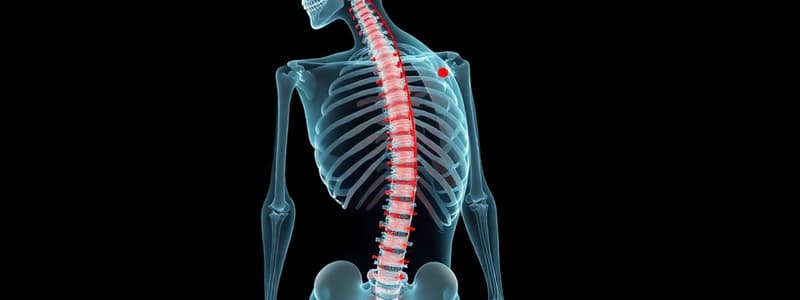Podcast
Questions and Answers
What adjustment should be made to the head in the lateral erect position?
What adjustment should be made to the head in the lateral erect position?
- Position the head so that the occipital bone obscures the posterior arch of the atlas
- Ensure the mandible is superimposed over the upper anterior cervical vertebra
- Adjust the head to prevent the angle of the mandible from superimposing over the upper anterior cervical vertebra (correct)
- Tilt the head backward to better visualize the entire cervical region
What should not occur regarding the angle of the mandible when positioning the patient?
What should not occur regarding the angle of the mandible when positioning the patient?
- Mandible angle can be adjusted to improve image quality
- Mandible angle superimposition is acceptable in basic positioning
- The angle of the mandible should not obscure the cervical vertebrae (correct)
- The angle of the mandible should be aligned with the occipital bone
What is a key consideration when positioning the head in a lateral erect position?
What is a key consideration when positioning the head in a lateral erect position?
- The patient should be angled at 90 degrees to the imaging receptor
- The head should be tilted forward to maximize view of the cervical spine
- The occipital bone should completely cover the atlas region
- The angle of the mandible must not obscure any cervical structure (correct)
What can be the consequence of improper head positioning during the examination?
What can be the consequence of improper head positioning during the examination?
When positioning the patient in the lateral erect position, which bone is particularly important to consider?
When positioning the patient in the lateral erect position, which bone is particularly important to consider?
What is the primary concern related to the angle of the mandible in relation to the cervical vertebrae?
What is the primary concern related to the angle of the mandible in relation to the cervical vertebrae?
Which anatomical feature should not obscure the posterior arch of the atlas when positioning the head?
Which anatomical feature should not obscure the posterior arch of the atlas when positioning the head?
In the lateral erect position, what is essential to avoid regarding the angle of the mandible?
In the lateral erect position, what is essential to avoid regarding the angle of the mandible?
What aspect of the lateral erect position is critical for imaging the upper anterior cervical vertebrae?
What aspect of the lateral erect position is critical for imaging the upper anterior cervical vertebrae?
What positioning adjustment minimizes superimposition of structures during imaging?
What positioning adjustment minimizes superimposition of structures during imaging?
Flashcards are hidden until you start studying
Study Notes
Lateral Erect (Basic) Position
- The angle of the mandible should be not superimposed over the upper anterior cervical vertebra.
- The occipital bone should not obscure the posterior arch of the atlas.
Cervical Vertebrae Lateral Erect (Basic) Positioning
- Patient position Lateral erect
- Image receptor position Lateral
- Head positioning:
- Angle of mandible not superimposed over upper anterior cervical vertebra
- Occipital bone does not obscure the posterior arch of the atlas
Studying That Suits You
Use AI to generate personalized quizzes and flashcards to suit your learning preferences.



